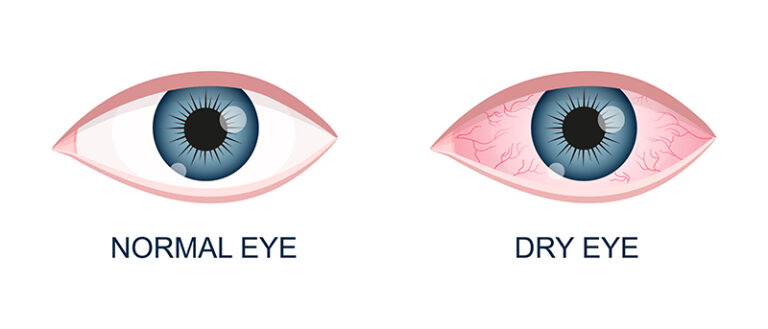
What is Dry Eye Syndrome?
Dry Eye Syndrome is a condition that occurs when tears cannot properly lubricate the eyes. Inadequate lubrication may be caused by a lack of tears, or poor-quality tears. This tear instability leads to a number of side effects and symptoms, and if left untreated, may cause lasting damage to the eye’s cornea surface along with declining vision.
There are two predominant forms of Dry Eye Disease: Aqueous Deficiency and Evaporative. The most common is evaporative dry eye, which affects up to 86% of dry eye sufferers. It is caused by meibomian gland dysfunction (MGD) or blocked glands that create a deficiency in the oil layer of the tear film. This can be the beginning of other dry eye disease problems including damage to the cornea and sight-related issues. The other form of dry eye disease is Aqueous deficiency, and that happens when the lacrimal glands produce tears with a low water component, making it impossible for the surface of the eye to remain sufficiently hydrated.
What are the Symptoms of Dry Eye Syndrome?
Dry Eye Syndrome results in inflammation and irritation, usually in both eyes, and may cause disturbances in your normal activities or lifestyle. Common symptoms and side effects of dry eye syndrome include:
- Dryness
- Tearing
- Discomfort and Irritation
- Sensitivity to light
- Grittiness
- Discharge
- Feeling of a foreign body in eye
- Tiredness
- Burning or stinging sensation
- Itching
- Vision Disturbance
- Redness
- Eye Fatigue
What Causes a Dry Eye Syndrome?
Dry eye syndrome develops when there is a disruption of the healthy tear film. The tear film has three layers: lipid (oil) layer, aqueous (water) layer, and the mucin layer. The combination of these layers is what keeps the surface of your eyes lubricated, smooth and clear. Though, if one of these layers is not functioning properly, it may trigger a decrease in tear production, tear quality, or an increase in tear evaporation, all resulting in dry eye syndrome. Problems with the tear film may be caused by a variety of reasons including hormone changes, autoimmune disease, inflamed eyelid glands or allergic eye disease.
Dry eye syndrome may also be brought on by other factors. Individuals over 50 are more prone to getting dry eye syndrome because tear production tends to diminish as we age. Women are also more prone to this as well, due to changes in their hormones during pregnancy, menopause, or if they are on birth control. Lifestyle may also be a cause as people whose diets are low in Vitamin A and omega-3 fatty acids are more at risk, along with those who wear contacts or have a history of getting refractive surgery.
How Will You Know If You Have It?
Treatment for dry eye syndrome largely depends on the severity of the disease, and any underlying conditions. Fortunately, in many cases, lubricating eye drops can be used to create artificial tears, or a doctor may prescribe medication to increase tear-stimulation or help with side effects such as eyelid and cornea inflammation.
If you suffer from a more severe case or are experiencing long term symptoms of dry eye syndrome, there are also a few clinically proven and minimally invasive procedures you may get that will unblock glands, interrupt physical deteriorations, and provide symptom relief.
If you feel like you may be suffering from dry eye syndrome, we suggest that in addition to being aware of the symptoms, you should take note of signs such as:
- Difficulty performing visual tasks such as reading, watching TV, and driving
- Inability to wear contact lenses
- Constant Use of Eye Drops
- Trouble being out in the sun
- Symptoms that worsen late in the day
Ocular dryness can be very uncomfortable and even damage the eye. We recommend that you maintain regular eye exams to diagnose any eye conditions and see a doctor if you are experiencing symptoms of dry eye syndrome. You may also refer to our services menu to learn more about Hawaiian Eye Center’s dry eye care, or contact one of our locations with any questions you may have.


